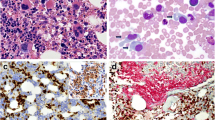Abstract
Blastic natural killer (NK) cell lymphoma corresponding to CD4+CD56+ malignancies is a novel disease entity, according to the results of clinical, morphologic, and immunologic studies. It is especially noteworthy that this disease likely arises from plasmacytoid dendritic cells (pDCs), described previously as plasmacytoid T-cells, which have an important role in innate and adaptive immunity. However, the exact relationship between the tumor cells and pDCs remains to be elucidated.We encountered a patient with typical blastic NK cell lymphoma, which later converted to leukemic manifestations, and tried to establish a cell line using the leukemic cells.We succeeded in establishment of a novel cell line,CAL-1, which originated from the primary malignant cells.The genetic and phenotypic features of CAL-1 cells bear a similarity to those of pDCs, namely, plasmacytoid morphology at light and electron microscopy; negative results for CD11c and lineage-associated markers of CD3, CD14, CD19, and CD16; positive results for HLA-DR, CD4, CD56, CD45RA, and CD123; and negative results for TCR and IgH gene rearrangements. An interesting finding was that CAL-1 cells change morphologically into the mature DC appearance with many long dendrites after short-term culture in the presence of granulocyte-macrophage colony-stimulating factor and interleukin 3.CAL-1 cells can secrete tumor necrosis factorαbut not interferon α.Thus although they do not share in part phenotypic and functional features with their normal counterparts, CAL-1 cells mostly exhibit a striking pDC phenotype.We describe the first novel pDC cell line of CAL-1.This cell line should open the opportunity for study not only of CD4+CD56+ tumor cells but also of pDCs in vitro.
Similar content being viewed by others
References
Adachi M, Maeda K, Kakekawa M, et al. High expression of CD56 (N-CAM) in a patient with cutaneous CD4-positive lymphoma. Am J Hematol. 1994;47:278–282.
Brody JP, Allen S, Schulman P, et al. Acute agranular CD4-positive natural killer cell leukemia: comprehensive clinico-pathologic studies including virologic and in vitro culture with inducing agents. Cancer. 1995;75:2474–2483.
Chan JK, Jaffe ES, Ralfkiaer E. Blastic NK-cell lymphoma. In: Jaffe ES, Harris LN, Stein S, Vardiman JW, eds. Pathology and Genetics of Tumors of Hematopoietic and Lymphoid Tissues. Lyon, France: IARC Press; 2001:214–215.
DiGiuseppe JA, Louie DC, Williams JE, et al. Blastic natural killer cell leukemia/lymphoma: a clinicopathologic study. Am J Surg Pathol. 1997;21:1223–1230.
Kameoka J, Ichinohasama R, Tanaka M, et al. A cutaneous agranular CD2-CD4+CD56+ lymphoma. Am J Clin Pathol. 1998;110:478–488.
Chaperot L, Bendriss N, Manches O, et al. Identification of a leukemic counterpart of the plasmacytoid dendritic cells. Blood. 2001;97:3210–3217.
Bene MC, Feuillard J, Jacob MC. Plasmacytoid dendritic cells: from the plasamacytoid T-cell to type 2 dendritic cells CD4+CD56+ malignancies. Semin Hematol. 2003;40:257–266.
Feulliard J, Jacob M-C, Valensi F, et al. Clinical and biological features of CD4+CD56+ malignancies. Blood. 2002;99:1556–1563.
Banchereau J, Steinman RM. Dendritic cells and the control of immunity. Nature. 1998;392:245–252.
Robinson S, Patterson S, English N, et al. Human peripheral blood contains two distinct lineages of dendritic cells. Eur J Immunol. 1999;29:2769–2778.
MacDonald KP, Munster DJ, Clark GJ, Dzionek A, Schmitz J, Hart DN. Characterization of human blood dendritic cell subsets. Blood. 2002;100:4512–4520.
Banchereau J, Schuler-Thurner B, Palucka AK, Schuler G. Dendritic cells as vectors for therapy. Cell. 2001;106:271–274.
Liu Y-J, Kanzler H, Soumelis V, Gilliet M. Dendritic cell lineage, plasticity and cross-regulation. Nat Immunol. 2001;2:585–589.
Leroux D, Mugneret F, Callanan M, et al. CD4+CD56+ DC2 acute leukemia is characterized by recurrent clonal chromosomal changes affecting 6 major targets: a study of 21 cases by the Groupe Francais de Cytogenetique Hematologique. Blood. 2002;99:4154–4159.
Kamihira S,Yamada Y,Tomonaga M, Sugahara K, Tsuruda K. Discrepant expression of membrane and soluble isoforms of Fas (CD95/APO-1) in adult T-cell leukaemia: soluble Fas isoform is an independent risk factor for prognosis. Br J Haematol. 1999;107:852–860.
Kamihira S, Yamada Y, Hirakata Y, et al. Aberrant expression of caspase cascade regulatory genes in adult T-cell leukaemia: survivin is an important determinant for prognosis. Br J Haematol. 2001;114:63–69.
Mitelman F, ed. An International System for Human Cytogenetic Nomenclature. Basel, Switzerland: Karger; 1995.
Schaefer TD, Desouza K, Fahey JV, Beagley KW, Wira CR. Tolllike receptor (TLR) expression and TLR-mediated cytokine/ chemokine production by human uterine epithelial cells. Immunology. 2004;112:428–436.
Grouard G, Rissoan MC, Filgueira L, Durand I, Bachehereau J, Liu YJ. The enigmatic plasmacytoid T cells develop into dendritic cells with IL-3 and CD40-ligand. J Exp Med. 1997;185:1101–1111.
Galibert L, Maliszewski CR, Vandenabeele S. Plasmacytoid monocytes/ T cells: a dendritic cell lineage? Semin Immunol. 2001;13:283–289.
Beiske K, Munthe-Kaas A, Davies CD, Marton PF, Godal, T. Single cell studies on the immunological marker profile of plasmacytoid T-zone cells. Lab Invest. 1987;56:381–393.
Herling M, Teitell MA, Shen RR, Medeiros LJ, Jones D. TCL1 expression in plasmacytoid dendritic cells (DC2s) and the related CD4+CD56+ blastic tumors of skin. Blood. 2003;101:5007–5009.
Comeau MR, Van der Vuurst de Vries AR, Maliszewski CR, Galibert L. CD123 (bright) plasmacytoid predendritic cells: progenitors undergoing cell fate conversion? J Immunol. 2002;169:75–83.
Author information
Authors and Affiliations
Corresponding author
About this article
Cite this article
Maeda, T., Murata, K., Fukushima, T. et al. A Novel Plasmacytoid Dendritic Cell Line, CAL-1, Established from a Patient with Blastic Natural Killer Cell Lymphoma. Int J Hematol 81, 148–154 (2005). https://doi.org/10.1532/IJH97.04116
Received:
Revised:
Accepted:
Published:
Issue Date:
DOI: https://doi.org/10.1532/IJH97.04116




